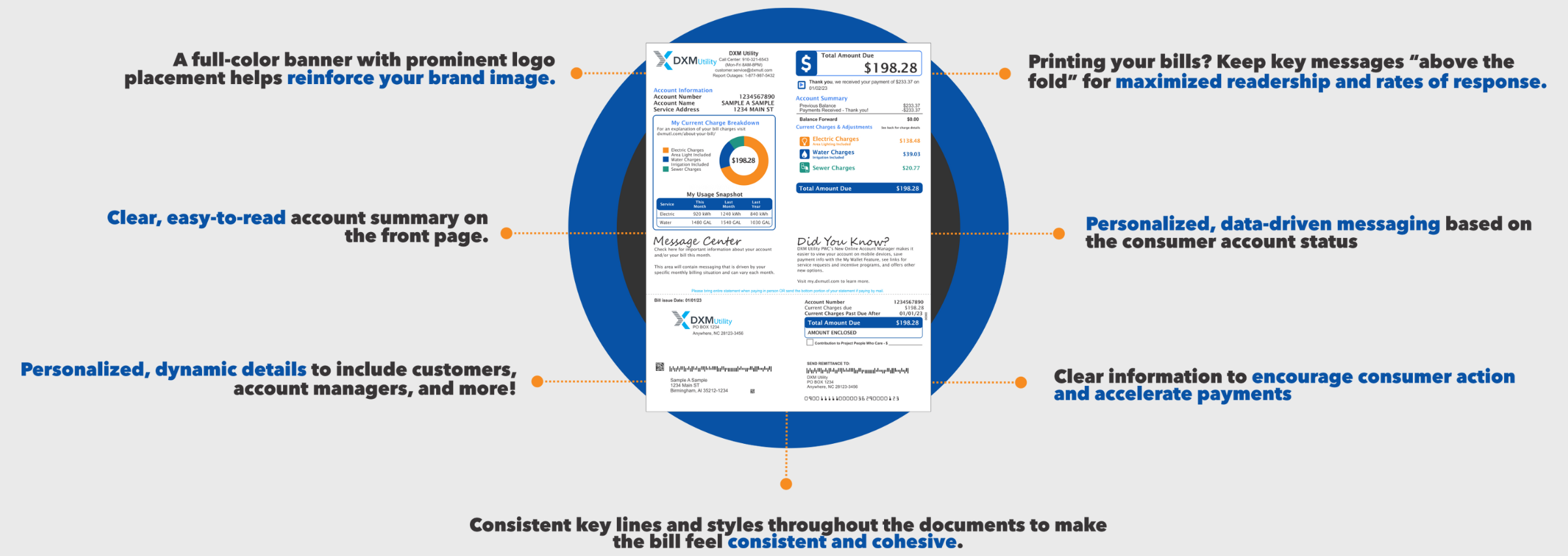The Guide to Successful Bill Design:
Close the Experience Gap
Curious to know more? Keep reading. This guide contains everything you need to know about using bill design to improve the customer experience.
What’s Inside:
The 3 Hidden Costs of Poor Bill Design
Delivering a basic paper invoice without attention to the bill design allows for three types of hidden costs– critical issues that impact your bottom line, including:
1. Missed Opportunities
Legacy bill composition processes hinder your ability to leverage bills as an effective marketing vehicle, which is a huge, missed opportunity!
Bills achieve a 95% open rate with customers, who, on average, take one to three minutes to read each document.
We all know how challenging it is to get consumers to pay attention to advertising. So, communicating key marketing messages via a bill, a document that customers actually open and read, is a win-win.
2. Customer Dissatisfaction
Confusing data, no matter its presentation, reduces customer satisfaction. When customers are unhappy and seeking answers, they increase calls to your customer service teams. And the average call center cost to manage a single customer phone call ranges between $5.50 and $8.00.
When poor bill design comes with such a high price tag, it makes sense to do everything you can to deliver good billing data. A little time and effort into creating a clean and clear bill design will reduce call center headaches while significantly improving customer satisfaction.
3. Missed Brand Impressions
Plain, out-of-the-box black and white bills with a basic layout and design do little to reinforce the brand image you need to communicate to your customers. It leads to wasted brand impressions.
Developing a modern bill design personalized to every customer but also closely aligned with other branding activities, improves the impression of your organization, and enhances the customer’s overall experience.
Improve Your Bill Design: 5 Areas for Analysis
The first step is to analyze your current bill design. Ideas to consider include:

- Your Audience & Key Demographic Segments: Who are they? Why are you sending them a bill? Once received, how will they use the information? Do you want to “speak” to each demographic? What do you know about these customers?
- Bill Layout: How is the information and data presented? Is critical information on page one (account summary, personalized contact details, etc.)?
- Strategic Programs: What key cross-sell or up-sell messages do you want to deliver? Is the bill a transactional document or also a marketing tool to increase brand awareness, products, services, or all the above?
- Method of Delivery: Do you deliver print and electronic bills? How can you maximize the value of these different delivery methods?
- Additional Information: Can you include additional information on or with the bill? If so, consider which other mailings you could eliminate.
A Note on Strategic Programs: Many utilities use the bill envelope to deliver inserts and buck slips to customers. But research shows that most of this secondary paper is discarded without a second glance. Their overall value is questionable.
Using bill design to put strategic messages directly on the document increases customers’ chances to view, read, and act. It also reduces the printing, shipping, storage, and inserting costs associated with pre-printed inserts.
Best of all, you can deliver all your messages to your customers, regardless of whether they receive their bills in printed or electronic format.
The 3 Key Elements of Good Bill Design
1. Direct the Eye: What are you emphasizing?
What you emphasize on a bill dictates where the customer’s eye lands when they look at the document. Consider which part of the bill you want the reader to focus on and use design elements like contrast, color, or call-out boxes to draw attention.
Here are a few more suggestions on how to direct the eye on your customer bills:
- Outline specific paragraphs to help put a visual emphasis on the content you want the reader to notice.
- Darker colors on bars in a graph draw the eye more compared to lighter colors.
- Avoid centered text as it leaves ragged edges, making it difficult to read.
- To increase reading comfort and legibility, consider the balance of printed “real estate” with the need for white space around the copy.
Research shows that most people prefer official communications to be somewhat formal, so the tone of language used on your bills is critical to providing clarity, too. Clarity also applies to the content arrangement. Adding key lines can help create defined sections, which is especially helpful for readers to comprehend the content quickly.
Your customers also expect to see contact information, summary data, and account numbers on predictable sections of the bill. Fulfilling these expectations makes the document feel more legitimate on a subliminal level.
When you build credibility, your customers trust you, which increases the efficacy of targeted ads by leading them to act, for example, by paying their bills promptly or signing up for automatic billing.
Take Your Bill Design to the Next Level
Click on image to enlarge
Work with a Trusted Communications Partner

A bill redesign project is exciting! But also incredibly complex.
You need a partner, someone who can guide the team on accessibility requirements, with the skills to implement customer-centric functionality to achieve industry-specific goals. For example, one area of frustration for customers is billing errors. A good billing partner should advise on an automated bill verification process to reduce the likelihood of sending an incorrect bill.
It’s why most utilities work with a trusted communications partner, like Doxim, who can best guide a bill design project and bring examples, learnings, and best practice bill models to the table.
For more information on best-in-class billing design, connect with one of our experts for details on how using our expert billing design, data management expertise, and seamless billing-to-payment process accelerates your revenue cycle, reduces call volumes, and communicates your strategic programs for optimal engagement.
Leverage our expertise to ensure your success!


